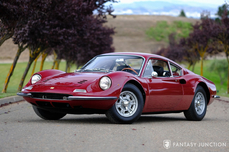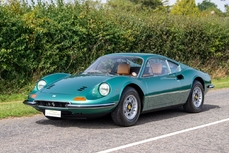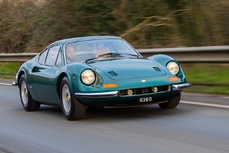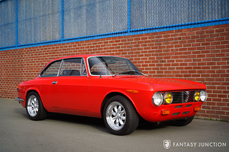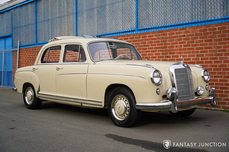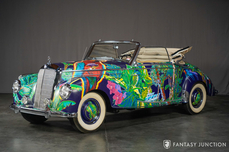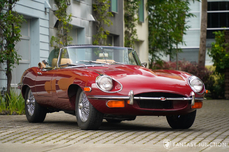Ferrari Dino 246 2.0L V6 1968
General description :
1968 Ferrari Dino 206 GT
s/n 00120
Rosso Dino with Nero/Panno Arancio Interior
Designed by the legendary Leonardo Fioravanti, responsible for some of the greatest Ferrari designs while at Pininfarina, the original 206 Dino GT offered a delightful design, full of undulating Italian curves, sensuality, and new performance standards inspired by racing successes Ferrari had achieved with their mid-engine prototypes. The heart of the Dino was the compact 65 degree V6 engine displacing 1987cc. With triple Weber 40DCF carburetors, the engine offered 160hp, a potent amount for a lightweight two-liter car. The transverse mid-engine design mated with a 5-speed transaxle offered spirited acceleration, besting many of the top competitors with larger displacement engines. Attributed in name, if not mostly in heart, to Dino Ferrari, son of Enzo, the Dino brand would launch Ferrari into higher levels of production and world-wide acclaim at a more achievable price. The powerful engine, however, was more the brainchild of legendary Vittorio Jano, of Lancia and Alfa Romeo fame, a detail that Jano graciously never boasted out of respect to the Ferrari family and as he too would tragically lose his son in 1965. Shortly after release, the 206 advanced to the larger displacement 246 Dino GT as public demand grew and production output increased for this new mid-engine car. The 246, stamped in steel using higher volume practices, would become one of the most popular sports cars of the period. Europe and America loved the sleek bodywork and nimble performance, responding with record sales and sustained popularity more than 50 years after the Dino was first introduced.
The 246 Dino would ultimately establish Ferrari as far more than a small volume manufacturer, paving the way for decades of mid-engine performance cars, but the 206 Dino, with its handmade alloy bodywork crafted at Scaglietti coachwork, uniquely defines the original concept in its purest form. Inspired by the 1965 Paris Salon 206 GT Speciale and followed by the Pininfarina 1966 Turin Salon display of the Dino Berlinetta GT, the subsequent 1967 Turin Salon and 1968 Brussels showing made clear Ferrari was intent on production, but the first offerings would be crafted slowly by hand until steel tooling could be prepared. Over the years, early Dino 206 examples have become more sought after due to their clean and pure body design, elegant detailing, and alloy coachwork. Early production 206 Dinos combining known provenance and superlative restoration are among the hardest to find and rarely come to market.
According to a copy of the Massini Report, prepared by noted Ferrari expert Marcel Massini, this 206 Dino Coupe was finished in Rosso Dino with Nero (Black) interior. Like all early Dinos, this car was configured in Left Hand Drive and is one of 154 alloy bodied cars produced. Completed in 1968, the car was delivered new to official dealer M. Gastone Crepaldi S.a.s. in Milan, Italy. In October 1968 the car was registered in Milan on Italian license plates. By the 1970s, the car had been exported from Italy to California where it is next known to have been owned by Howard L. Ashmore, resident of San Jose, CA. By the 1980s, Ashmore sold the car to a collector in Japan where it appears to have remained under Tokyo, Japan ownership attributed to ‘Shimizu’ who retained the car from 1998-2000. In February 2014 the car is offered for sale, once again in Tokyo. Later that same year the car is offered for sale at Copley Motorcars, MA and sold to the current owner.
Shortly after his purchase, the current owner delivered the car to Boston Sportscar Company, particularly well-known for their mechanical work on Ferraris and other performance cars. All suspension and steering components were removed, gearbox and engine removed and disassembled, and all parts sorted, studied, and prepared for rebuild. Over $30,000.00 was spent preparing these components. By 2015, the restoration project was moved to Ferrari experts Rex Nguyen Restorations, Marina Del Rey, CA where a highly detailed four-year restoration documented with receipts totaling over $250,000.00 was performed to an exceptionally high standard. During the restoration the car was completely disassembled, and the body placed on a rotisserie for comprehensive metal work. Both the alloy skin and steel frame were carefully evaluated to determine where factory chassis welds had weakened over the years and how to best address the alloy bodywork that had been subject to mild but evident use. All body panels were properly finished by hand and mated to the body surfaces with attention to the door, hood, and engine lid gaps. Typical to these cars, rocker panel contouring often becomes wrinkled over time due to alloy to steel stresses. Not only were these areas carefully addressed, much of the mating subframe and floor construction was extensively refined and finished to a very high standard. The metal work alone totaled over $50,000.00. Once all body work was completed, proper surface primer was applied to refine the curvaceous Dino bodywork and all body panels were blocked for single stage PPG Rosso Dino paint using DU5 hardener and PPG reducer. The correct satin black underbody painting was also applied following proper factory guidelines for the early Dino models.
While the body was being prepared, all suspension, brakes, engine, gearbox, and supporting electrical systems were thoroughly addressed either being replaced with correct newly sourced parts or original parts restored with cadmium plating, bead blasting and powder coating for suspension parts, proper finishing and polishing as needed, and correct coatings applied before reinstallation on the car. The interior was fully reupholstered as well using correct materials sourced from respected vendors including the correct dashboard materials, proper terry cloth Dino seat inserts (unique to early 206 cars) in correct Panno Arancio. These seat inserts, known as “Beach Seats”, feature a terry cloth material in typical Italian fashion style, for those wishing to drive to the beach, go for a swim, and return to drive home, presumably in a damp bathing suit. Fashion aside, the final finishes in the restoration addressed literally every aspect of the car including wiring, electrical details under the front storage compartment, beautifully finished wheels and chrome plated knockoff hubs, and a very high-quality reproduction tool kit. In every respect, the restoration represents this car to a very high standard, suitably so given the rarity of this remarkable early alloy Dino.
Today this 206 Dino presents as a beautifully and freshly finished example. Every aspect of the restoration has come together remarkably well. The paint has been expertly applied with excellent coverage, glass-like reflections, crisp lines, and vivid color. The finish is not only fresh and beautifully detailed, the doors shut with precision fit and hold position flush to the body surfaces, vastly improving on even factory specifications. The only modest variation is seen on the driver’s side of the engine lid, sitting slightly proud of the body surface. The chrome trim is bright and virtually unmarked with gleaming reflections. The trim, window molding, emblems, and badges are all in exceptional condition with the windshield showing only slight indications of light wiper marks. Glass lenses and turn indicator lenses are also in bright, clear condition, properly detailed with new gaskets and excellent fit to the body. The Cromodora wheels have been correctly refinished including the chrome center knockoffs, which are properly plated and unique to these early Dinos.
The beautifully restored interior reflects the stunning color combination of red and black, notably outfitted with the rare terry cloth “Beach Seat” inserts. Not only are the seating and door panel surfaces restored to a very high standard, the materials are correct, and the detailing is very well done in the corners, seams, and continues through the underside of the dashboard as well as inside the elongated glovebox door, excellent carpeting, and center console. The main gauges are highly contrasting with bright numeric indication and excellent finish. The 5-speed gated shift plate and signature Dino switches and hardware further convey the sporting nature of these early cars. The delightful array of instruments is set off by a beautifully finished and correct wood steering wheel, featuring a bright yellow Dino center emblem. In all, the interior presents a handsome color combination finished with pride and excellence.
Under the hood, the 2.0L V6 engine has been thoughtfully restored and detailed with originality in mind. The engine components have been prepared to concourse standards featuring the honest and unpretentious quad cam castings of the earlier series cars, purely reflecting the mechanical beauty as they were naturally cast. A few of the engine accessories have been refinished in select areas including the satin black air cleaner, and of course the hoses, clamps, and accessories are correct for the period. The rear trunk area is nicely finished with correct carpeting and the front storage compartment features a full-sized spare tire with matching wheel, and a correctly finished inner molded tire tub. Here too, even the fuse area is impeccably detailed reflective of factory finishes. The underside of the car is further evidence of the level of restoration performed on the entire car, featuring correct castings, factory type finishes, comprehensively rebuilt suspension and brakes, and properly specified lines, hoses, and a new exhaust system. There is no evidence of significant structural compromise as is evident in the rotisserie photos documenting details of the chassis and bodywork during the restoration.
Driving this Dino, one is reminded of the praise these cars received upon introduction, raving about the balance achieved with the mid- engine layout and V6 power. The engine lights up on contact with a snappy start and eager idle as it warms up on choke. Once at burbling idle, the synchromesh gearbox engages easily and shifts smoothly as power comes on strong in each gear, pulling through low rpms and delighting drivers with more pull as the revs climb higher. Indeed, when pressed into the upper rev range, this is where the Dino truly begins to show its capabilities. Braking and suspension are surprisingly good even by modern standards, certainly improved wearing a fresh set of correctly sized Michelin XWX tires. The car is accompanied by a very nice quality set of reproduction tools, roll, jack, and hammer as well as the road safety triangle. A very fine set of reproduction owner’s manuals and leather pouch, a Dino key fob, a copy of the Massini report, and copies of the restoration receipts and photos documenting the restoration are also included with the car.
Unquestionably one of the most beautifully designed sports cars ever conceived, this 206 Dino GT is not only rare, it is the spiritual grandfather of every mid-engine Ferrari produced, even those built today. With such rarified genes, one of 154 alloy bodied Dinos built, matching numbers, and stunning restoration, the nimble performance capability coupled with the history of Enzo’s passionate salute to the vision of his young son Dino Ferrari, this exquisite 206 Dino is sure to be welcomed at any of the finest motorsports or concours events throughout the world.
https://fantasyjunction.com/inventory/1968-ferrari-dino-206-gt/overview
1968 Ferrari Dino 246 2.0L V6 is listed sold on ClassicDigest in Emeryville by Fantasy Junction for $649500.
Car Facts
Car type : Car Make : Ferrari Model : Dino 246 Model Version : 2.0L V6 Engine size : 2.0 Model Year : 1968 Location : Emeryville Vehicle Registration : Normal
Sold
Seller Information
Sold
People who viewed this Ferrari Dino 246 also viewed similar Ferrari listed at ClassicDigest
Other cars listed for sale by this dealer
About Ferrari
The first Ferrari road car was the 125 S introduced in 1947 and powered by a 1.5 L V12 engine, right? Well it's not quite that simple, Ferrari did in fact produce e Tipo 815, in 1940. Tipo 815 was designed by ex-Alfa Romeo engineers Alberto Massimino and Vittorio Bellentani and by Enrico Nardi under Enzo's company but legal issues with the former associate Alfa Romeo prevented Ferrari from launching the Ferrari marque at that point.
Enzo did produce a series of fine road cars in the 50's and 60's but they were merely to finance his true passion racing, wheather GT/Sports car or Grand Prix. The 50's saw the birth of Ferrari's most memorable cars, 250 GTB (tour de France) 250 Testa Rossa, 250 GT swb just to name a few.
Under the surface tension was growing though. In November 1961 long-time sales manager Girolamo Gardini made an ultimatum to Enzo: if tensions continued, he would leave the company. As a result, Gardini was ousted, as well as Scuderia Ferrari manager Romolo Tavoni, chief engineer Carlo Chiti, experimental sports car development chief Giotto Bizzarrini, and a number of others who stood by them.
Without Chiti and Bizzarrini the development of what was to become the most quintessential Ferrari and today the world's most expensive car, 250 GTO, was at a pivoting point. 250 GTO project was saved by a young engineer Mauro Forghieri and long-time racing bodyman Sergio Scaglietti who stepped in and took over the program with known results.
In addition to 250 GTO, Ferrari launced such master pieces as 250 LM, 250P, 275 GTB, 365 GTB/4 "Daytona" during the the 60's
By the late 60's Ferrari's prototypes' success came to a sudden halt by a new competitor, GT40. Ford turned to Lola to produce a Ferrari beating long distance racer after Enzo had cut the deal off with Henry Ford II making the latter absolutely boil with fury. The collaboration between Ford and Lola created the mighty Ford GT40 that gave Ferrari some heavy hits in Le Mans 24 to come.
By the end of the 60's FIAT purchased 50% of the company, starting a development that has led to a new mass-produced era of Ferraris.
Whether you are selling or looking for a classic Ferrari www.classicdigest.com is the place to check out.



